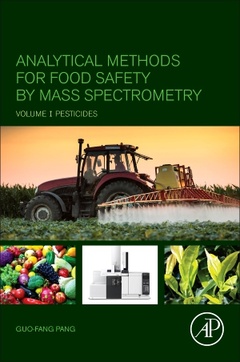Analytical Methods for Food Safety by Mass Spectrometry Volume I Pesticides
Auteur : Pang Guo-Fang

Analytical Methods for Food Safety by Mass Spectrometry, Volume One: Pesticides systematically introduces the Pesticide and Veterinary Drug Multiresidues Analytical Methods. Volume One includes discussions on 20 pesticide multiresidues chromatic-MS (GC-MS and LC-MS/MS) analytical techniques that have the capability of detecting over 800 pesticides and chemicals in 10 categories of agricultural products, including fruits, vegetables, grains, teas, Chinese medicinal herbs, edible fungus mushrooms, fruit and vegetable juices, animal tissues, aquatic products, raw milk and milk powders, and drinkable water. This book also includes chromatic-MS analytical parameters, linear equations and GPC chromatic behavior parameters for over 800 pesticides.
This valuable book can be used as reference for not only university students, but also technical personnel of different specialties who are engaged with study and applications, such as food safety, agricultural environment protection, pesticide development, and utilization in scientific research units, institutions and quality inspection organizations.
students and technical personnel of different specialties engaged with technical study and applications such as food safety, agricultural environment protection and pesticide development and utilization in scientific research units, institutions, and quality inspection organizations.
- Provides the chromatic-MS analytical technique for over 1000 commonly-used veterinary and pesticide residues
- Covers a large varieties of target compounds, including over 800 pesticides (organophosphorus, organochlorine, carbamate, pyrethroids) and over 200 veterinary drugs, including Fluoroquinolone, Sulfonamides, Chloramphenicol, Nitrofurans, Tetracyclines, Nitroimidazole, ß-lactams, Quinoxaline, Benzimidazole, ß-Adrenoceptor agonists, Aminoglycoside, and more
- Includes the latest information on sophisticated pre-treatment techniques with a single sample pre-treatment and simultaneous detection by GC-MS and LC-MS/MS
Date de parution : 06-2018
Ouvrage de 880 p.
15x22.8 cm
Thèmes d’Analytical Methods for Food Safety by Mass Spectrometry :
Mots-clés :
<; p>; chemical contaminants analysis; Pesticides; Veterinary Drugs; Food Safety; Mass Spectrometry; chemical residues; fruit juice; vegetable juice; fruit wine; gas chromatography; grains; tea; mushrooms; GC-MS; Barbary wolfberry; mulberry twig; LC-MS-MS; drinking water; chemical pollutants; Sulfonamides; ß-agonists; streptomycin; Aminoglycoside; kanamycin; dihydrostreptomycin; chloramphenicol; thiamphenicol; florfenicol; ß – lactams; amoxicillin; ampicillin; piperacillin; penicillin G; penicillin V; oxacillin; cloxacillin; nafcillin; dicloxacillin; Macrolides; ivermectin; abamectin; doramectin and eprinomectin; Nitrofurans; Anabolic steroids; Inanabolic steroids; Glucocorticoid; Fluoroquinolone; Tetracyclines; Sedative; Pyrazolone; Quinoxaline; Nitroimidazole; Benzimidazole; Levamisole; Thiourea; Polyether<; /p>



